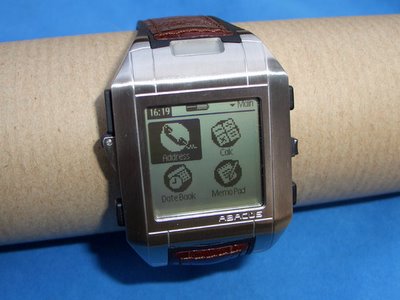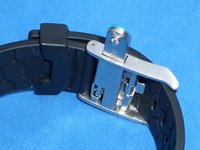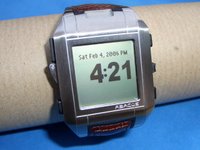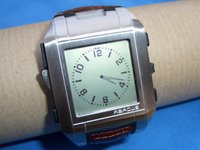
Well folks, please give a big hand to the latest item to gather dust at the bottom of the gadget drawer. Only kidding. For now. I'm actually trying to wear this thing on a daily basis. Have a read of the review and see what you think.
The Wrist-PDA is a gadget which is simultaneously great, and awful, at the same time. It's great because it's a tiny computer. On your wrist. It's awful because it's sometimes hard to operate and goes through it's battery faster than the Duracell Bunny. More on that later.
 First, all the good stuff. This watch seems to be a later model and as such bears the Abacus brand. It's still a Fossil watch, however, and as such it is built to a very high standard. It's solidly constructed, but not that tough really, since the screen is touch sensitive and not in any way water resistant. The smart stainless steel bezel is large but is less cumbersome than [say] the Casio Pro-Trek. The watch is fairly thick - dimensionally, heh - but no more than a substantial diver's chronograph IMHO. Sadly, the buttons are plastic when they could easily have been metal, but it still manages to retain the look of a smart timepiece.
First, all the good stuff. This watch seems to be a later model and as such bears the Abacus brand. It's still a Fossil watch, however, and as such it is built to a very high standard. It's solidly constructed, but not that tough really, since the screen is touch sensitive and not in any way water resistant. The smart stainless steel bezel is large but is less cumbersome than [say] the Casio Pro-Trek. The watch is fairly thick - dimensionally, heh - but no more than a substantial diver's chronograph IMHO. Sadly, the buttons are plastic when they could easily have been metal, but it still manages to retain the look of a smart timepiece.Neatly set into the top of the bezel is a frosted IR window. The bezel gives way to a strange resin mock croc hybrid strap. The strap is large and needs to be fastened right at the last notch for my thin, mayfly-like, wrists. Mind you, this is tight, but not quite enough to stop the blood reaching my hand. Any looser and the watch has a tendency to ride down on the wrist and chafe the hand. Not good.
On the wrist the watch feels good - substantial, yes, but really not too bad and I found I forgot about it being there after a while.
On one side, there is a small rubber flap hinged, rather incongruously. This is the USB port and is a rather endearing reminder that it's really a small computer, complete with small port flaps.
I love port flaps. Especially the ones that detach and get lost forever.
 The case back is nicely etched with the Abacus logo and more importantly the Palm logo. There is even a tiny USB logo etched near the port, bless.
The case back is nicely etched with the Abacus logo and more importantly the Palm logo. There is even a tiny USB logo etched near the port, bless.Lastly, there is the buckle. Usually the least exciting part of any watch, this buckle conceals a tiny stylus for operating the PDA. It slides out and folds open and like the watch itself is finely engineered out of stainless steel and plastic. Too bad it looks like you've just produced a tiny toothpick.

Onto the actual operation of the Wrist PDA. Are there any bionic doctors in the house? Because you'll need the dexterity of a brain surgeon and Colonel Steve Austin's eye to get the best out of this gadget.
You see, the screen is essentially a 160x160 standard monochrome Palm display, replete with standard Palm screen furniture - buttons, navigation, menus and scroll-bars. The photo shows the large, low-res icons - you can make them really small via a preferences screen. They're just so tiny. Picking the tiny scroll-arrow on a moving platform (like a bus) is nigh on impossible.
 The good news is that the standard Palm PIM applications are all present in their full functionality. I happily beamed 2 years worth of calendar entries from my Palm T3 in a matter of seconds. The same with my complete contacts list. Everything present and correct and working just like it's bigger version. Apparently, most applications targeted at OS ver 4 can be installed in it's 8Mb of memory.
The good news is that the standard Palm PIM applications are all present in their full functionality. I happily beamed 2 years worth of calendar entries from my Palm T3 in a matter of seconds. The same with my complete contacts list. Everything present and correct and working just like it's bigger version. Apparently, most applications targeted at OS ver 4 can be installed in it's 8Mb of memory.Like other Palms, much of the basic navigation can be achieved with the exterior buttons. The central control is a two-way toggle that also presses in to select an option. The button below the USB port acts as a 'back' button, which I don't think is standard on regular Palm devices. The two remaining buttons on either side of the toggle act as 'page up' and 'page down' functions.
The obvious difference between the watch and a regular Palm is the lack of the input area. This is usually a screen printed area that responds to you 'writing' characters and numbers. However, like more recent Palms, the screen itself can be written on. Astoundingly, the watch is better at text recognition than the T3. Like the T3 it uses Grafitti 2 but has another tool called Jot to help understand my scrawl. It does a good job and it's surprisingly easy to get text into the device. If you don't mind looking a prat on the train while doing so, that is.
If writing on the screen isn't your thang, you can call up a teeny virtual qwerty keyboard, but book an appointment with an optician before doing so, because you WILL go blind using it.
 Ha! I nearly forgot! It's a watch too! It keeps good time [for a computer] and the bonus is it sports several different ways of telling the time from plain digital (using a nice sans-serif font) to analogue and several funky displays in between. There are additional watch faces that can be downloaded, too.
Ha! I nearly forgot! It's a watch too! It keeps good time [for a computer] and the bonus is it sports several different ways of telling the time from plain digital (using a nice sans-serif font) to analogue and several funky displays in between. There are additional watch faces that can be downloaded, too.
Well, that's all the interesting stuff. Onto the major down side of all this wrist-bound magic. The battery.
Most watches these days offer up to three years or more of use out a single cell. Even the power hungry Pro-trek is still on it's first set of CR2032s. The Wrist-PDA? Well, three days is the norm. I'm not kidding. If this was an iPod, there would be a car battery accessory available. You can't leave it in a drawer for a week without it dying. However, the designers seem to be aware of this shortcoming and have built in some power-saving features but even then getting 5 days would be stretching things.
The up side is that, as long as you sync with the computer regularly, this shouldn't be a problem. It does need a 3-4 hour charge it's Li-Ion cell, so doesn't fall into the grab'n'go category like most gadgets. But then my iPod is usually flat when I go to use it so I'm used to that.
Also, you do get a tiny, multi-standard mains charger, albeit with US pins. The watch seems happy to be charged via USB alone and it works with the USB cable that came with the Sony PSP so not a total disaster if you lose the cable.
In summary, this is a great, super geeky gadget to have. It's a shame the battery requires daily attention, but that is price you pay to have a COMPUTER on your WRIST!
Next week: Creating a Wrist-PDA out of an Apple Newton MessagePad 100. [That's a joke btw!]
See also engadget and of course our old friend, eBay.
A nice review with some good close-up pics of the Fossil version of the watch can be found here.
No comments:
Post a Comment